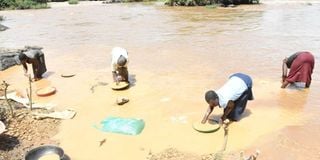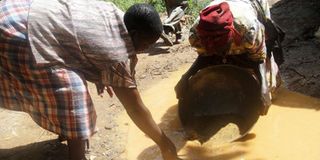The golden girls of Kakamega and Migori

What you need to know:
- Traditions don't allow women to step on the gold shelter because 'they will cause the gold to disappear'.
- Ms Matsisa has to be up by 4am to go camp at the shaft to ensure she is counted for an allocation of the ores.
- It's a tiring job. Sometimes you feel like the joints on the back have disconnected.
- They can go for three to four months without getting any gold.
- Masitsa not aware of any dangers of prolonged exposure to mercury used in extracting gold.
It is a few minutes after 9am. The warm sun rays penetrate through a timber shelter on the edge of a plantation at Sabane village in Ikolomani Sub-county, Kakamega County.
Below is a fountain deep shaft fitted with a rotating wooden pole with handles on both ends. Three 20-litre jerricans fastened with thick ropes rolled on the pole hang over the shaft.
Ms Prisca Matsisa, 42, stands on the side of the shaft with her hands to the back as she watches six men wear their protective gear to start excavating mine.
Short-haired Ms Matsisa wearing brown stained rubbers, a pink-blue squared ankle length skirt and a brown striped blouse leads us to this gold pit.
Culture
Here, cultural norms and traditions play out in the gold mining business.
This year, marks eight years since Ms Matsisa, a widow and a mother of five, started dealing in gold. But not once has she ever stepped on the shelter.
“There is no way women can step over here,” says Mr Erick Agoi, a foreman at the shaft.
“It is believed that they will cause the gold to disappear once they step on the fresh soil from the hole. We can't risk to allow them here,” he emphasises.
And so Ms Matsisa, maintains her position on the edge of the pit as we continue with the interview under the shelter.
Gold pit
Mr Agoi is leading the morning shift crew relieving others who have been extracting the gold ore since 5pm, the previous day. It's a 24-hour economy.
Men work for a three to four-hour shift and women have to keep up with the momentum lest they get nothing from the mining.
For instance, Ms Matsisa, whose home is five minutes from the gold pit, has to be up by 4am to go camp at the shaft.
This is to ensure she is counted for an allocation of the ores once they complete the shift at 5am.
“I have no other means of raising my children,” she says.
“My husband died leaving me with small children. I can't get a better job to feed my children since I only studied up to Class Seven,” she explains.
Dangerous business
Her husband died 20 years ago.
She tried farming but the harvests were too little for home consumption and a profit. She decided to try her luck in the business when she heard villagers boast of good proceeds from the business.
But it's a dangerous business. Sometimes costly and quite often pegged on hope and perseverance.
In this village, there are two options to get yourself the gold ores. You either subscribe to a group with a membership fee of Sh4,000 or buy a spadesful for Sh200.
As a member, you are given a share of the ores extracted without buying. Both male and female members present during the distribution get an equal share. Ms Matsisa is a member of Bidii Mining Group, which constitutes 30 women and 50 men. Thus, has to be present for her share.
Tedious process
There is, however, no guarantee that one will find gold in the ores shared or bought.
“You can go for three to four months without getting any gold. You cannot give up either as you never know when you'll strike some,” says Ms Matsisa.
“It's tiring. Sometimes you feel like the joints on the back have disconnected. They crack when you stand after long hours of bending while labouring to separate gold from silt,” she adds.
For the women in this artisanal gold mining, getting clean and marketable gold is a long, tedious process.
It takes about a week to complete the process. But what is more worrying is that the women do not wear any protective gear. They have no gloves, masks or even goggles. Without these, their health is at risk as they increase their chances of inhaling or ingesting poisonous chemicals, especially mercury which they use to separate gold from the silt as well as smoke, dust and small stones.

Prisca Matsisa, 42, helps a colleague clean gold at Sabane village in Ikolomani Sub-county, Kakamega County.
With nothing over her nose, eyes or on her hands, Ms Matsisa, starts off with cleaning the ores at Sabane River, before crushing them into small pieces and puts them out in the sun to dry.
When dry, she takes the ores to stamp mill for grinding into powder. A 50kg bag of the ores costs Sh400 to mill. She also has to spend another Sh200 to transport the product back and forth.
She makes another trip to Sabane River. This time, she needs a sackcloth laid on a slanted rack. She mixes the powdered ore with water and splashes it on the slanted sack lock. In this process, the gold is sieved.
She then washes the sackcloth in a basin of water to get the gold off the cloth to water.
Amalgamated gold
It is this water that she mixes with mercury, followed by tiresome moments of gently moving the water in circles over and over again, and stirring the mix with one hand to amalgamate the gold on mercury. All this while bending.
When mercury turns white, she knows it has amalgamated gold. She then burns the mercury. It evaporates and the gold in its yellow colour, remains. A gram retails at Sh3,400 and a unit at Sh70.
Ms Matsisa is not aware of any dangers of prolonged exposure to mercury but she says even if she knew, they could not stop her from scavenging for gold.
“I stop, then I eat what?” she asks.
Although, this venture puts women's health at risk, they seem not to have a better alternative as farming is neither profitable nor cereal business.
“I sold my cow and used the proceeds to start a cereal business,” says Ms Truphesa Shisinga, 50.
“I could buy a 90-kg bag of maize for Sh2,400 then suddenly the prices hiked to Sh4,000. I couldn't make any more profits. I gave up and decided to try my hand in gold mining," says the widow.
Chest, back pains
For the two months, she has been in the gold mines, she has had constant chest and back aches.
She, however, says “I am getting the grip of it. I must preserve, otherwise, my son and I will die of hunger.”
She walks for 9.2km from Chandumba village in Sabatia Sub-county, Vihiga County to be at Sabane gold mines by 7am. She starts to trek at 5am.
For Ms Jennifer Muhala, 58, the dust from crushing the stones and pouring the powdered ores has had an effect on her chest.
“Sometimes, I have terrible coughs and I feel pain piercing through my chest. But I take some pain killers and syrup. It's work. I have to do it,” says Ms Muhala, who owns a mine claim with her husband.
Feed children
The risks notwithstanding, the women have changed the perception of gold mining in Kakamega County.
“Men never took gold mining for an economic activity. It was leisure for them and so they wasted all the income on alcohol leaving their families hungry,” says Sabane assistant chief Mr Naphtali Mutsotso.
“Things started to change about 10 years ago when women said enough is enough. So, when you see a woman toiling at the gold mine, scavenging for gold from the mud, the end result that you are so sure of is a meal for the children,” he says.
In Migori gold mines, about 221km from Kakamega, the women’s predicaments are replicated.
Ms Mary Auma has to walk for five kilometres from Kadem village to be at Osiri-Matanda gold mines in Nyatike Sub-county by 7am.
Crush stones
The 52-year-old wakes up at 5am to complete her house chores. She ensures she starts off the journey before 6am. Her work is to crush stones.
“Usually, the stones are allocated early in the morning. If I'm late, I won't find a job to do,” says the widow.
In a good day, the mother of one takes home Sh250. For a basin full of the crushed stones, she is paid Sh70.
Just like in Kakamega, one has to be in a group to get an allocation of the stones. The other option is to buy them.
In the case of Ms Auma, she is a casual labourer of the men who take part in the extraction. They offer women the temporary jobs of processing the gold.
There are times though, Ms Auma feels too weak and at pains to work - her arms, shoulders, back and chest often hurt. The thought of her son sleeping hungry, however, gives her the energy to push herself to the limits.
More women
It is this similar zeal that Ms Pamela Otieno, a widow, has armed herself with.
The mother of seven, has been in this gold business since 2005. She started with crushing stones then graduated into buying and selling gold. Now, she runs her own stamp mill at the mine.
Men, she says, never allowed women to process the gold or even own any machine in the gold mine. Then, about 10 years ago, things changed.
“There were more and more women coming in to look for jobs. Then the men came to a decision that ‘let the women crush the stones, let them do the washing and stirring as we do the extraction.’ And that is how things started to slowly change,” she says.
Now, more than 500 women work at the gold mine, says Ms Otieno who is also the chairperson of Kajosi Women Group, constituting of women working at the mine.
In the past five years, two women, have withdrawn from the mine due to eye problems, she says.
Prolonged exposure
“Their eyes were itchy because of the dust and coarse particles getting into the eyes,” she says.
"They had worked here for about five years crushing stones," she adds.
Gold mining may be solving women’s financial needs, but the processes of getting the gold expose the women to fatal effects.
Research scientist at Health and Systems for Health Unit at African Population and Health Research Center (APHRC), Dr Gershim Asiki, elaborates the adverse effects of prolonged exposure to mining activities.
He says poisonous chemicals such mercury and cyanide even at low levels can damage kidneys, nerves and the lungs. They can get into the body through inhaling, ingesting or through the skin.
“Other indirect effects arise from the behaviour of women due to their seasonal migrations predisposing them to high risk behaviours that facilitate the spread of sexually transmitted infections and HIV,” he says.





